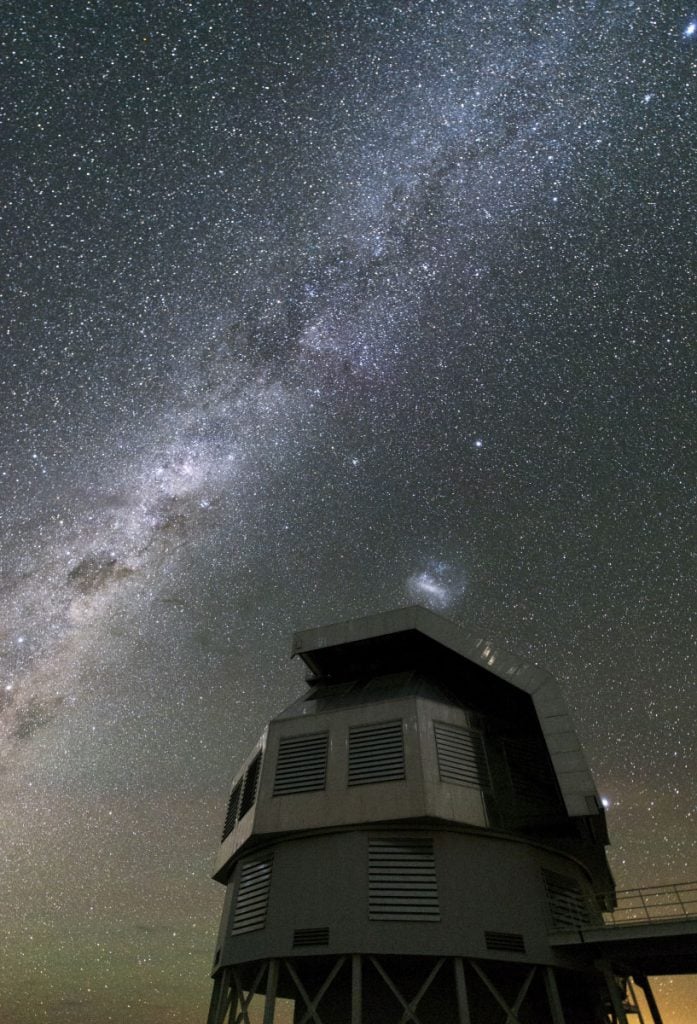
Observations of the yellow supergiant runaway were conducted using the large 6.5-meter Magellan telescope at Las Campanas Observatory. The Large Magellanic Cloud (companion galaxy to the Small Magellanic Cloud, not shown) is visible right above the telescope enclosure. The bright band of light from lower left to upper right is the southern Milky Way. Photo by Kathryn Neugent.
Astronomers have discovered a rare “runaway” star that is speeding across its galaxy at 300,000 miles (480,000 kilometers) per hour (at that speed it would take about half a minute to travel from Los Angeles to New York). The runaway star (designated J01020100-7122208) is located in the Small Magellanic Cloud, a close neighbor of the Milky Way Galaxy, and is believed to have once been a member of a binary star system. When the companion star exploded as a supernova, the tremendous release of energy flung J01020100-7122208 into space at its high speed. The star is the first runaway yellow supergiant star ever discovered, and only the second evolved runaway star to be found in another galaxy.
After ten million years of traveling through space, the star evolved into a yellow supergiant, the object that we see today. Its journey took it 1.6 degrees across the sky, about three times the diameter of the full moon. The star will continue speeding through space until it too blows up as a supernova, likely in another three million years or so. When that happens, heavier elements will be created, and the resulting supernova remnant may form new stars or even planets on the outer edge of the Small Magellanic Cloud.
The star was discovered and studied by an international group of astronomers led by Kathryn Neugent, a Lowell Observatory researcher who is also a graduate student at the University of Washington in Seattle. The team included Lowell staff members Phil Massey and Brian Skiff, Las Campanas (Chile) staff astronomer Nidia Morrell, and Geneva University (Switzerland) theorist Cyril Georgy. Their findings have been accepted for publication in the Astronomical Journal. The discovery was made using the National Optical Astronomy Observatory’s 4-meter Blanco telescope, and the Carnegie Observatory’s 6.5-meter Magellan telescope, both located in northern Chile. Their work was funded by the National Science Foundation.
The north-pole star, Polaris, is a yellow supergiant, as is Canopus, one of the brightest stars visible from the southern hemisphere. Yellow supergiants are very rare objects because the yellow supergiant phase is so short. A massive star may live for as much as ten million years but the yellow supergiant phase itself lasts only ten to a hundred thousand years, an eye-blink in the life of a star. After this short time, yellow supergiants expand into giant red supergiants, like Betelgeuse, with sizes as large as the orbits of Mars or Jupiter. These stars eventually die in spectacular supernova explosions.
Reference: “A Runaway Yellow Supergiant Star in the Small Magellanic Cloud” by Kathryn F. Neugent, Philip Massey, Nidia I. Morrell, Brian Skiff1 and Cyril Georgy5, 24 April 2018, The Astrophysical Journal.
DOI: 10.3847/1538-3881/aab964
ABSTRACT: We recently discovered a yellow supergiant (YSG) in the Small Magellanic Cloud (SMC) with a heliocentric radial velocity of ∼ 300 km s−1 which is much larger than expected for a star in its location in the SMC. This is the first runaway YSG ever discovered and only the second evolved runaway star discovered in a different galaxy than the Milky Way. We classify the star as G5-8I, and use dereddened broad-band colors with model atmospheres to determine an effective temperature of 4700 ± 250K, consistent with what is expected from its spectral type. The star’s luminosity is then L/Lo ~ 4.2+/-0.1, consistent with it being a ~30Myr 9Mo star according to the Geneva evolution models. The star is currently located in the outer portion of the SMC’s body, but if the star’s transverse peculiar velocity is similar to its peculiar radial velocity, in 10 Myr the star would have moved 1.6◦ across the disk of the SMC, and could easily have been born in one of the SMC’s star-forming regions. Based on its large radial velocity, we suggest it originated in a binary system where the primary exploded as a supernova thus flinging the runaway star out into space. Such stars may provide an important mechanism for the dispersal of heavier elements in galaxies given the large percentage of massive stars that are runaways. In the future we hope to look into additional evolved runaway stars that were discovered as part of our other past surveys.








That is really amazing! This rare event could mean something.